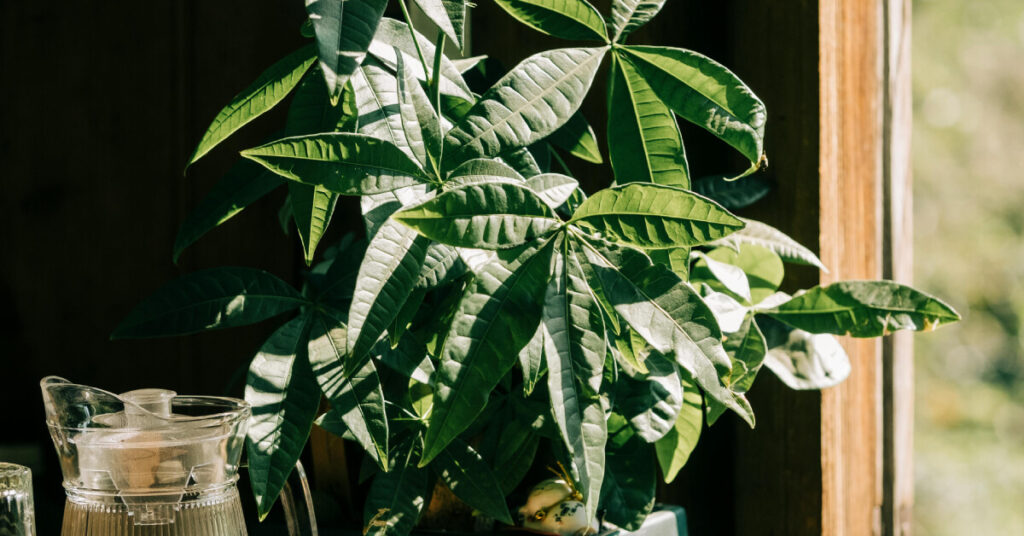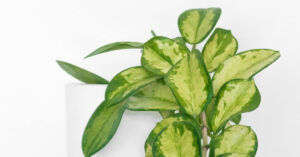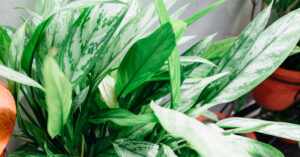Pachira aquatica
Few houseplants combine striking visual appeal with such rich cultural symbolism as the Money Tree. With its distinctive braided trunk, glossy palmate leaves, and reputation for bringing good fortune and prosperity, the Money Tree has become one of the most sought-after houseplants for both aesthetic and spiritual reasons. Whether you’re drawn to its feng shui associations or simply appreciate its unique architectural form, this remarkable plant offers an impressive presence that transforms any indoor space.
Native to the wetlands of Central and South America, the Money Tree’s natural habitat might surprise you – these plants can grow as towering trees reaching 60 feet in the wild. However, when cultivated as houseplants, they maintain a manageable size while retaining their characteristic braided trunk and distinctive hand-shaped leaves that create an elegant, tropical atmosphere in your home.
The Money Tree’s reputation for bringing wealth and good luck stems from feng shui traditions, where it’s believed to attract positive energy and financial prosperity. This cultural significance, combined with its relatively easy care requirements and striking appearance, has made it a popular choice for homes, offices, and businesses seeking both beauty and symbolic meaning.
Understanding the Money Tree’s Unique Structure
The Money Tree’s most distinctive feature is its braided trunk, which is actually created by intertwining multiple young plants together during cultivation. This braiding process, typically done when the plants are young and flexible, results in the characteristic twisted trunk that makes each Money Tree a living sculpture. As the plants mature, the individual trunks continue to grow together, creating an increasingly impressive braided base.
The glossy, palmate leaves emerge from the braided trunk in groups of five to seven leaflets, creating the hand-shaped foliage that adds to the plant’s visual appeal. Each leaflet is oval-shaped with a pointed tip and can reach 4-6 inches in length. The leaves have a beautiful, deep green color with a natural sheen that catches and reflects light beautifully.
In their natural habitat, Money Trees can produce showy flowers and large, woody seed pods, though flowering is extremely rare in indoor cultivation. The energy that would typically go into flowering is instead directed toward foliage growth and trunk development, resulting in the lush, architectural plants we know as houseplants.
Mastering Light Requirements
Money Trees thrive in bright, indirect light that mimics the dappled sunlight of their native forest canopy. Place your plant near an east or north-facing window, or several feet back from a south-facing window where it receives plenty of ambient light without harsh direct sun exposure. This positioning typically provides the ideal balance of brightness without the intensity that can damage the leaves.
While Money Trees can tolerate lower light conditions better than many houseplants, insufficient light will cause the plant to become leggy as it stretches toward available light sources. You may notice the spaces between leaves becoming longer and the overall growth becoming sparse and weak. In very low light, the plant may also drop some of its lower leaves.
Direct sunlight can scorch the Money Tree’s leaves, causing them to develop brown, crispy edges or fade to a pale yellow-green. If you notice these symptoms, move your plant to a location with gentler light. The ideal lighting produces vibrant, deep green foliage with good spacing between leaf nodes, indicating healthy, compact growth.
Watering Wisdom for Healthy Roots
One of the Money Tree’s greatest advantages as a houseplant is its tolerance for irregular watering, making it ideal for busy plant parents or those still learning proper watering techniques. Allow the soil to dry out completely between waterings, then water thoroughly until water drains from the bottom holes. This typically means watering every 7-10 days during the growing season and less frequently in winter.
The Money Tree’s tolerance for drought stems from its ability to store water in its braided trunk, similar to succulent plants. This adaptation allows it to survive periods of neglect that would stress or kill other houseplants. However, this doesn’t mean you should neglect watering entirely – consistent moisture during the growing season promotes the best growth and foliage development.
Overwatering is far more dangerous to Money Trees than underwatering. Soggy soil quickly leads to root rot, which can kill the plant. Signs of overwatering include yellowing leaves, soft or mushy trunk areas, and a sour smell from the soil. If you suspect overwatering, reduce watering frequency and ensure your pot has adequate drainage holes.
Creating the Perfect Soil Environment
Money Trees require excellent drainage to prevent the root rot that can quickly kill these otherwise resilient plants. A well-draining potting mix designed for cacti and succulents works perfectly, or you can create your own blend using equal parts regular potting soil, perlite, and coarse sand or orchid bark.
The key is creating a soil mix that allows water to flow through freely while still providing some nutrients for growth. Avoid heavy, clay-based soils or potting mixes that retain too much moisture, as these can create the soggy conditions that lead to root problems.
Money Trees aren’t particularly fussy about soil pH and will grow well in slightly acidic to neutral conditions. More important than pH is ensuring the soil drains well and doesn’t compact over time, which can impede both drainage and root development.
Temperature and Humidity Adaptation
Money Trees are remarkably adaptable to typical indoor temperature ranges, thriving in temperatures between 65-80°F (18-27°C). Unlike many tropical houseplants, Money Trees can tolerate some temperature fluctuation without showing stress, making them suitable for homes with varying heating and cooling patterns.
While Money Trees can handle temperature variations better than most houseplants, they should still be protected from extreme cold drafts and sudden temperature changes. Keep them away from frequently opened doors, windows, and heating or cooling vents that might create uncomfortable conditions.
These plants adapt well to average home humidity levels, though they appreciate slightly higher humidity when possible. If your home is particularly dry, especially during winter heating seasons, consider using a humidifier or placing the pot on a pebble tray filled with water to increase local humidity levels.
Fertilizing for Optimal Growth
During the growing season (spring through early fall), feed your Money Tree monthly with a balanced, water-soluble fertilizer diluted to half strength. A 10-10-10 or 20-20-20 fertilizer provides the balanced nutrition needed for healthy foliage development and steady growth of the braided trunk.
Money Trees don’t require heavy feeding and can actually be damaged by over-fertilization, which can cause leaf burn and excessive, weak growth. Signs of over-fertilization include brown leaf tips, very soft growth, and salt buildup on the soil surface. If you notice these symptoms, flush the soil with plain water and reduce fertilizing frequency.
During winter months, reduce or eliminate fertilizing as the plant’s growth naturally slows. Resume regular feeding in spring when you notice new growth beginning. The Money Tree’s relatively slow growth rate means it doesn’t need the frequent feeding that faster-growing plants require.
Pruning and Shaping Your Money Tree
Money Trees rarely require extensive pruning, but occasional maintenance helps keep them looking their best. Remove any yellowing, damaged, or dead leaves by cutting them at the base of the stem. This prevents potential pest and disease issues while keeping the plant’s energy focused on healthy growth.
You can also prune to control size and shape, cutting back any branches that have become too long or are growing in unwanted directions. When pruning, make cuts just above a leaf node to encourage new growth from that point. The Money Tree’s relatively slow growth rate means pruning won’t need to be done frequently.
If your Money Tree becomes too tall for your space, you can cut back the main stem to the desired height. The plant will typically respond by producing new growth from lower nodes, creating a bushier appearance. However, be aware that this type of heavy pruning can stress the plant and should be done sparingly.
Understanding Repotting Needs
Money Trees prefer to be slightly rootbound and don’t require frequent repotting. Plan to repot every 2-3 years or when you notice roots growing through the drainage holes. When repotting, choose a container only slightly larger than the current pot, as Money Trees can struggle in oversized containers that hold too much moisture.
The best time to repot is in spring when the plant is beginning its active growing season. Use fresh, well-draining potting mix and be gentle with the roots, as Money Trees can be sensitive to root disturbance. Water sparingly after repotting until you see signs of new growth, indicating the plant has adjusted to its new container.
When repotting, inspect the roots carefully for any signs of rot or damage. Healthy roots should be white or light-colored and firm to the touch. If you find any soft, dark, or mushy roots, trim them away with clean scissors before repotting in fresh soil.
Propagation Possibilities
Money Trees can be propagated from stem cuttings, though the process requires patience as these plants are slow to root and establish. Take 6-8 inch cuttings from healthy stems, making sure each cutting includes several nodes where roots can develop. Remove the lower leaves and place the cuttings in water or moist, well-draining potting mix.
Root development typically takes 4-6 weeks, and the process is often more successful in warm, humid conditions. You can increase humidity around the cuttings by covering them with a plastic bag or placing them in a propagation chamber. Once roots are well-developed, gradually acclimate the new plants to normal growing conditions.
Keep in mind that propagated Money Trees won’t have the characteristic braided trunk of the parent plant unless you manually braid multiple cuttings together when they’re young and flexible. This braiding process requires several plants and considerable patience to achieve the desired effect.
Common Challenges and Solutions
Despite their reputation for being low-maintenance, Money Trees can face several common issues. Yellowing leaves are often the first sign of overwatering, though they can also indicate natural aging of older leaves. Examine the soil moisture and adjust your watering schedule accordingly.
Leaf drop can occur due to various stress factors including overwatering, underwatering, temperature changes, or insufficient light. Money Trees may drop leaves when first brought home as they adjust to new conditions, but persistent leaf drop usually indicates a care issue that needs addressing.
Spider mites can become a problem in dry conditions, causing stippling on leaves and potential webbing. Increase humidity and treat with insecticidal soap if necessary. Scale insects may also occasionally affect Money Trees, appearing as small, brown bumps on stems and leaves.
Embracing the Money Tree’s Symbolism
Whether or not you believe in the Money Tree’s reputation for bringing financial prosperity, there’s no denying the positive energy this beautiful plant brings to any space. Its unique appearance, easy care requirements, and impressive presence make it an excellent choice for both experienced plant parents and beginners looking for a statement plant.
The Money Tree’s combination of practical benefits and symbolic meaning creates a houseplant that offers both aesthetic pleasure and cultural significance. As you care for your Money Tree and watch it grow, you’re participating in a tradition that spans cultures and generations, nurturing not just a plant but a symbol of hope, prosperity, and natural beauty that enhances your daily life.




